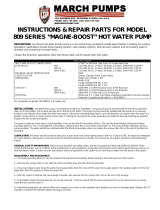Declaration of conformity
19
Declaration of conformity
GB: EC declaration of conformity
We, Grundfos, declare under our sole responsibility that the products
DPK, to which this declaration relates, are in conformity with these
Council directives on the approximation of the laws of the EC member
states:
CZ: ES prohlášení o shodě
My firma Grundfos prohlašujeme na svou plnou odpovědnost, že
výrobky DPK, na něž se toto prohlášení vztahuje, jsou v souladu
s ustanoveními směrnice Rady pro sblížení právních předpisů
členských států Evropského společenství v oblastech:
DE: EG-Konformitätserklärung
Wir, Grundfos, erklären in alleiniger Verantwortung, dass die Produkte
DPK, auf die sich diese Erklärung bezieht, mit den folgenden Richtlinien
des Rates zur Angleichung der Rechtsvorschriften der EU-Mitglieds-
staaten übereinstimmen:
ES: Declaración CE de conformidad
Nosotros, Grundfos, declaramos bajo nuestra entera responsabilidad
que los productos DPK, a los cuales se refiere esta declaración, están
conformes con las Directivas del Consejo en la aproximación de las
leyes de las Estados Miembros del EM:
HR: EZ izjava o usklađenosti
Mi, Grundfos, izjavljujemo pod vlastitom odgovornošću da je proizvod
DPK, na koji se ova izjava odnosi, u skladu s direktivama ovog Vijeća
o usklađivanju zakona država članica EU:
IT: Dichiarazione di conformità CE
Grundfos dichiara sotto la sua esclusiva responsabilità che i prodotti
DPK, ai quali si riferisce questa dichiarazione, sono conformi alle
seguenti direttive del Consiglio riguardanti il riavvicinamento delle
legislazioni degli Stati membri CE:
LT: EB atitikties deklaracija
Mes, Grundfos, su visa atsakomybe pareiškiame, kad gaminys DPK,
kuriam skirta ši deklaracija, atitinka šias Tarybos Direktyvas dėl Europos
Ekonominės Bendrijos šalių narių įstatymų suderinimo:
HU: EK megfelelőségi nyilatkozat
Mi, a Grundfos, egyedüli felelősséggel kijelentjük, hogy a DPK
termékek, amelyekre jelen nyilatkozik vonatkozik, megfelelnek az
Európai Unió tagállamainak jogi irányelveit összehangoló tanács alábbi
előírásainak:
ID: Deklarasi kesesuaian dengan EC
Kami, Grundfos, dengan ini menyatakan bertanggungjawab terhadap
produk DPK yang terkait dengan pernyataan ini sesuai dengan
peraturan perundang-undangan dan ketentuan hukum negara-negara
anggota Komunitas Eropa:
PL: Deklaracja zgodności WE
My, Grundfos, oświadczamy z pełną odpowiedzialnością, że nasze
wyroby DPK, których deklaracja niniejsza dotyczy, są zgodne
znastępującymi wytycznymi Rady d/s ujednolicenia przepisów
prawnych krajów członkowskich WE:
PT: Declaração de conformidade CE
A Grundfos declara sob sua única responsabilidade que os produtos
DPK, aos quais diz respeito esta declaração, estão em conformidade
com as seguintes Directivas do Conselho sobre a aproximação das
legislações dos Estados Membros da CE:
RU: Декларация о соответствии ЕС
Мы, компания Grundfos, со всей ответственностью заявляем,
что изделия DPK, к которым относится настоящая декларация,
соответствуют следующим Директивам Совета Евросоюза об
унификации законодательных предписаний стран-членов ЕС:
RO: Declaraţie de conformitate CE
Noi, Grundfos, declarăm pe propria răspundere că produsele DPK,
la care se referă această declaraţie, sunt în conformitate cu aceste
Directive de Consiliu asupra armonizării legilor Statelor Membre CE:
SK: Prehlásenie o konformite ES
My firma Grundfos prehlasujeme na svoju plnú zodpovednost’, že
výrobky DPK, na ktoré sa toto prehlásenie vzt’ahuje, sú v súlade
s ustanovením smernice Rady pre zblíženie právnych predpisov
členských štátov Európskeho spoločenstva v oblastiach:
SI: ES izjava o skladnosti
V Grundfosu s polno odgovornostjo izjavljamo, da so naši izdelki DPK,
na katere se ta izjava nanaša, v skladu z naslednjimi direktivami Sveta
o približevanju zakonodaje za izenačevanje pravnih predpisov držav
članic ES:
RS: EC deklaracija o usaglašenosti
Mi, Grundfos, izjavljujemo pod vlastitom odgovornošću da je proizvod
DPK, na koji se ova izjava odnosi, u skladu sa direktivama Saveta za
usklađivanje zakona država članica EU:
TR: EC uygunluk bildirgesi
Grundfos olarak bu beyannameye konu olan DPK ürünlerinin, AB Üyesi
Ülkelerin kanunlarını birbirine yaklaştırma üzerine Konsey Direktifleriyle
uyumlu olduğunun yalnızca bizim sorumluluğumuz altında olduğunu
beyan ederiz:
CN: EC 产品合格声明书
我们格兰富在我们的全权责任下声明,产品 DPK,即该合格证所指之产
品,符合欧共体使其成员国法律趋于一致的以下欧共理事会指令:
KO: EC
DPK
– Machinery Directive (2006/42/EC).
– Low Voltage Directive (2006/95/EC).
Standards used: EN ISO12100-1: 2003,
EN ISO12100-2: 2003 and EN 13386: 2002.
Suzhou, 14th December 2010
Søren Ishøy
R&T Manager
GRUNDFOS Pumps (Suzhou) Ltd.
No. 72, Qingqiu Road
Suzhou, Jiangsu, 215126, China (CN)
Person empowered to sign the EC declaration of conformity.
Svend Aage Kaae
Technical Director
Grundfos Holding A/S
Poul Due Jensens Vej 7
8850 Bjeringbro, Denmark
Person authorised to compile technical file.























